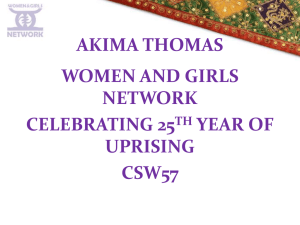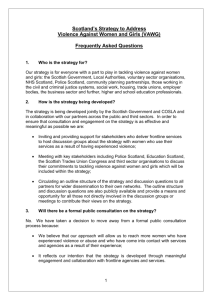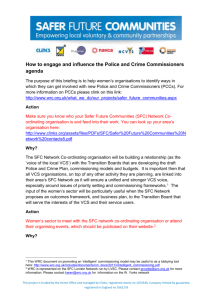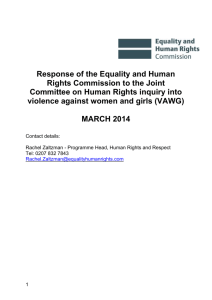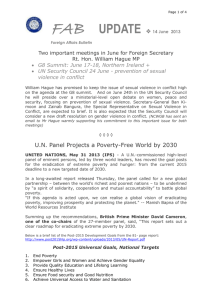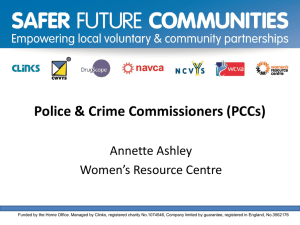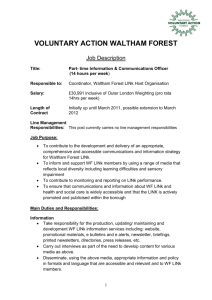Domestic Violence - VAWG Strategic Mission Statement
advertisement
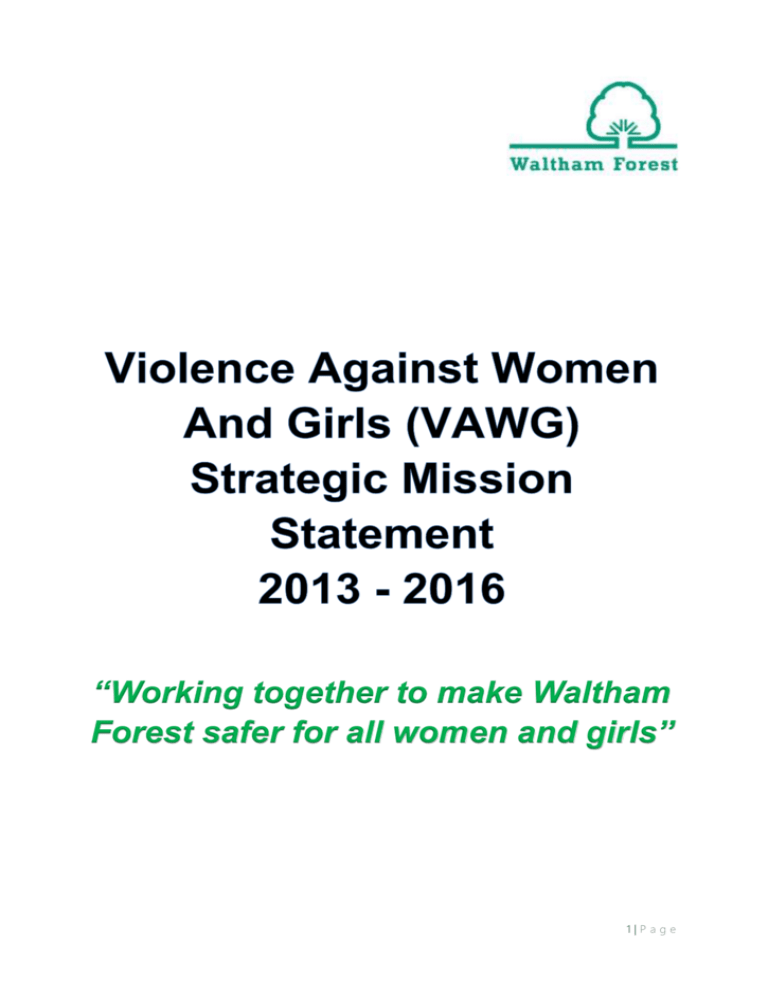
“Working together to make Waltham Forest safer for all women and girls” 1|Page 1. OUR VISION This document heralds Waltham Forest Council’s vision for responding to Violence Against Women and Girls (VAWG hereafter). Our vision for this work will be delivered through an integrated 3-year action plan which will support the Home Office strategy: Call to End Violence against Women and Girls, 2010, a copy of which can be located at: http://www.london.gov.uk/sites/default/files/The%20Way%20Forward%20Final%20Strategy.pdf and will also be in line with the recently published second Mayoral strategy on VAWG (2013 – 16). Responding to VAWG must be everybody’s business. By developing a diverse and ambitious VAWG strategic mission statement and action plan, the partnership is clearly articulating our concern about the issue of VAWG in our community and our commitment to address it. As it is so complex and touches so many people's lives, we recognise that addressing VAWG will require the support and commitment of the entire Community Safety Partnership and other strategic partnership boards working within Waltham Forest including the Health and Wellbeing Board, the Local Safeguarding Children Board and the Adults' Safeguarding Board. To demonstrate the borough’s multi agency partnership to VAWG this strategic mission statement has been agreed by the following boards: Health and Wellbeing Safeguarding Children’s Board Adult Safeguarding Board Along with the Council, other statutory agencies (such as the police and health services), voluntary sector organisations, and the wider community will also be a key part of this work. Working together, the borough’s partnership will help us respond to all forms of VAWG so that we are able to: Prevent abuse before it happens through education, awareness work Intervene earlier on to reduce repeat victimisation and the harm it causes Stop it from happening again Make sure victims1 (and their families) are provided with adequate information, support and care Help to increase the safety and options of people experiencing any form of VAWG Challenge attitudes and beliefs that underpin and condone VAWG by a coordinated approach to prevention and awareness work Raise awareness of VAWG, why it is important and what individuals can do to help address it Take action to hold perpetrators accountable for their behaviour Support perpetrators to understand the impact of their crime and change their behaviour The strategic mission statement has used the term “victim”. We acknowledge that many people (both adults and children/young people) who have experienced any form of VAWG may not necessarily identify with this term and that this term may not accurately describe a persons experience. Where the word victim is stated in this document it should be read and understood as: “victim/survivor/those individuals seeking support/person(s) who have experienced any form of VAWG”. 1 2|Page Be publicly accountable for our work in responding to all forms of VAWG Support and ensure that agencies and services to work together in a coordinated community response to obtain the best outcome for victims and their families. 2. WHAT IS MEANT BY THE TERM “VIOLENCE AGAINST WOMEN AND GIRLS? In line with the Government’s and the Mayor of London’s strategy the United Nations (UN) Declaration (1993) on the elimination of VAWG has been adopted by the borough. VAWG is defined as: ‘Any act of gender-based violence that results in, or is likely to result in, physical, sexual or psychological harm or suffering to women, including threats of such acts, coercion or arbitrary deprivation of liberty, whether occurring in public or in private life’. The UN declaration enshrines women’s rights to live without the fear of violence and abuse. VAWG includes the following crime types: Sexual violence, abuse and exploitation Sexual harassment and bullying Stalking Trafficking and forced prostitution Domestic violence and abuse Female genital mutilation Forced marriage Crime committed in the name of “honour”. 3. WHAT DO WE KNOW ABOUT VAWG IN WALTHAM FOREST? Due to the nature of the different forms of VAWG it is difficult to obtain accurate data to tell us how much of it is happening, to whom, and where. We acknowledge that our existing information on VAWG is particularly sparse and what information we do have is mostly in relation to criminal justice data relating to domestic violence. Our VAWG action plan will work to address this lack of data. This is important so we have better intelligence on all forms of VAWG so that we are better placed to understand the local issues and respond effectively to it. The information below provides a limited understanding of the nature of VAWG in the borough: In the 12 months to July 2013 there were 1,910 domestic violence crimes reported to the police – this is the 7th highest rate of recorded domestic violence crimes in London. Domestic violence offences make up over one third of violence against the person offences. Historical data suggested that domestic violence is present in around half of all child protection cases. Since January 2013, 197 ‘high risk’ cases of domestic violence and abuse have been referred to the Multi Agency Risk Assessment Conference (MARAC) and 226 children and young people have been recorded residing within these households. 3|Page Area Home Office iQuanta data showed that as of the 31st March 2011 Waltham Forest had the 17th highest level of sexual offences within the Metropolitan Police Service. Waltham Forest has the sixth highest rate of prostitution related incidents recorded by the Metropolitan Police Service from August 2010 to June 2011. Prostitution incidents make up less than 1% of all recorded anti-social behaviour incidents within Waltham Forest. Prostitution incidents are concentrated in Lea Bridge, Cathall and Forest and William Morris wards. Waltham Forest had the highest estimated number of pregnant women with FGM and percentage of all maternities to women with FGM (2001 – 2004) across the four outer north east London boroughs. 2001 number 128 % 2002 % 2003 % 2004 % Total Number Number Number Number 3.68 143 4.03 174 4.66 189 4.82 635 Waltham Forest Barking and 82 3.42 100 4.15 122 4.74 Dagenham Redbridge 103 3.33 114 3.56 125 3.73 Havering 6 0.26 8 0.36 15 0.64 A Statistical Study to Estimate the Prevalence of Female Genital and Wales Summary Report, Forward 2007 167 6.8 471 156 4.51 498 17 0.67 47 Mutilation in England 4. BACKGROUND TO THE VAWG STRATEGIC MISSION STATEMENT Waltham Forest Council’s Community Safety Partnership (known locally as ‘SafetyNet’) http://www.walthamforest.gov.uk/pages/services/local-area-agreements.aspx is in the process of developing a multi-agency integrated and comprehensive approach to tackling all aspects of VAWG. Our first VAWG strategic mission statement is an ambitious piece of work. We are taking the bold step to develop a comprehensive response that addresses all forms of VAWG and this is a watershed moment in our work in this area. Much work has already been conducted across the borough by various multi-agency task and finish groups, project and programme boards, aimed at addressing all forms of VAWG. From this work, a great deal of information and good practice has been identified such as the: Specialist Domestic Violence and Abuse Training to increase awareness and understanding of the complexities and barriers of sexuality, gender identity and disability. The Healthy Relationship Training (HEART) programme – elements of the programme were piloted in Waltham Forest, Newham and Lewisham in response to concerns raised regarding several young people that has been brought to the attention of several agencies. HEART is a prevention programme that was designed to support young women and men, improve the relationships they have with both peers and boy/girlfriend. 4|Page MARAC Champions Training programme – Earlier this year 15 members of the MARAC Safety Planning team attended Coordinated Action Against Domestic Abuse (CAADA) Champions Training. These champions represent various agencies and will be utilised by the partnership to deliver multi agency training and raise awareness of the MARAC process across the partnership and within our communities. Independent Domestic Violence Advocate (IDVA) Service – Waltham Forest Community Safety Team has secured additional funding to increase the IDVA provision in the borough. The borough now has a compliment of 6 IDVAs located across the partnership in the following areas: (1) Children Social Care and Early Intervention and Prevention Service, (2) Metropolitan Police Community Safety Unit, (3) Whipps Cross Hospital Accident and Emergency and Maternity Suite and at the (4) Specialist Domestic Violence Court located at Stratford Magistrates Court. This will enable the IDVA service to undertake additional local surgeries across the borough and to work with partner agencies such as housing to increase awareness and provide a coordinated community response to domestic violence. The aim will be to increase confidence in reporting domestic violence crime. This strategic mission statement and action plan will build upon this foundation of good practice. The strategic mission statement is a public commitment on our plans to address VAWG in the borough. Section 11 of the document: “Implementation and measuring progress” explains how we will ensure progress is made on our work and how we will communicate this. 5. THE ECONOMIC COSTS OF VAWG If we can respond to VAWG more effectively and earlier on we know that not only will we reduce the devastating harm it causes victims, their families and the wider community, but services can make significant cost and resource savings. We know that VAWG has a significant financial impact on borough services. We have a moral and legal duty to get better at responding to VAWG both to prevent it and to also make better use of resources to address the problems and issues that are associated with it. The financial costs of VAWG is staggering, for example, using the spreadsheet from The Cost of Domestic Violence: by local authority, Trust for London and the Henry Smith Charity (2011) the estimated total costs of domestic violence (not including the human and emotional costs) pro-rated by population for the borough is £26 million, the hidden costs to NHS is £7.8 million. Ashiana Network “Journey Towards Safety” (2011) social return on investment research showed the high social return on investment ratio created by Ashiana’s specialist refuge and outreach services for black and minority ethnic women. For every pound invested, eight pounds worth of social value is created. A comparatively small level of investment yields significant results. Investment in specialist services such as Ashiana creates significant benefits which can mitigate the high financial and 5|Page emotional costs of experiencing domestic violence and harmful practices such as forced marriage and honour based violence. Understanding the economic cost of VAWG is important as we are undertaking this ambitious programme of work at a time when resources are limited. This mission statement is underpinned by the principle that VAWG can only be effectively addressed by all borough agencies and services working together as part of a properly coordinated community response to address all forms of VAWG. This is because no one agency has all the answers to the complex issues and challenges of VAWG. Agencies need to work together so that they hold each other accountable for their responses in ensuring that victims and their families get the help they need from a range of services. The partnership will strengthen a unified understanding of VAWG and will support innovative and creative responses to VAWG. 6. THE PARTNERSHIP’S UNDERSTANDING OF VAWG This mission statement is based on the overarching understanding that we all have a role to play in ending violence against women and girls. The multi-agency partnership in Waltham Forest has agreed a joint understanding of VAWG which will help guide and support our work. This is important and necessary so that we all have the same position towards VAWG and agree on how best to address it. The partnership’s belief and understanding of VAWG is that: VAWG is harmful to victims, children/young people, families and the wider community; VAWG is against the law; VAWG overwhelming affects women and girls; Despite being hidden and under reported, VAWG is a global issue and is common in all sections of our community; All forms of VAWG are wrong and must never be justified or condoned; Increasing the safety of victims must be a priority for all agencies; Specialist services are needed to help respond to the needs of victims and their families; Services and agencies should work together to ensure that victims are given all opportunities to get the support they need; Victims should not be blamed and services and agencies should not be judgemental of victims; All agencies and services must work together if we are to successfully address VAWG; Agencies must be responsible for holding perpetrators accountable and support them to get the help they need to change their behaviour Men and boys are part of the solution. 7. WALTHAM FOREST’S APPROACH TO VAWG We recognise that our response to VAWG will initially focus predominantly on domestic violence. This is because our response to date has focused on this area and we have 6|Page more established systems in place for dealing with this problem. We are committed to building a comprehensive response to other types of VAWG. In the first phase of our action plan, we will focus on mapping all forms of VAWG. This intelligence gathering will help improve our understanding of what is happening locally to help inform our action plan. Ensuring all aspects of VAWG get equitable attention will be significant challenges; however we are committed to ensuring that all types of VAWG will be included in our action plan. 8. WHAT DOES THIS MEAN FOR MALE VICTIMS? The term ‘violence against women and girls’ can understandably cause concern about the exclusion of men and boys from services and a lack of recognition that men and boys can also experience the VAWG crime type. The partnership recognises that VAWG is gendered. This means that the VAWG crime types: (sexual violence, abuse and exploitation; sexual harassment and bullying; stalking; trafficking and forced prostitution; domestic violence and abuse; female genital mutilation; forced marriage and crime committed in the name of “honour”) are more likely to be experienced by women and are committed against them because they are gender specific (such as female genital mutilation). Our gendered approached is based on the knowledge and understanding that women and girls disproportionately experience these different forms of violence. Importantly because we recognise the disproportionality of the VAWG crime types, it means that men and boys are not excluded, from our work as they can be victims of forms of VAWG too, and that perpetrators can also be female. VAWG is considered by the government, the European Union and The United Nations as a barrier to gender equality and also a consequence of inequality. The partnership is committed to ensuring that every victim of VAWG regardless of their protected characteristics (as outlined in the Equality Act 2010): age, disability, gender reassignment, marriage and civil partnership, pregnancy and maternity, race, religion or belief, sex, sexual orientation: receives a sensitive and appropriate response so that they get the help and support they need. Our response to VAWG will therefore be inclusive. This mission statement should also be read in conjunction with the Council’s Equality and Diversity Policy Statement which can be located on the Council website at; http://www.walthamforest.gov.uk/Pages/Services/Equalities-and-diversity-assessmentand-consultation.aspx Because we know that some forms of VAWG can all be experienced by males our work on VAWG work will help improve services for all victims of crime. We also recognise the not all men will experience forms of VAWG in the same way. The experience of gay, bisexual and transgender men will be different with different risks, needs and barriers to accessing appropriate support services. In our inclusive approach we will work to improve the understanding about the experience of VAWG for lesbians, bisexual and transgender women. We know that this is a very hidden problem that needs attention and there is a complex link between homophobic, biphobic or transphobic hate crime and VAWG. 7|Page For this work to be successful and relevant it is important that men and boys are included in all aspects of the strategy, especially our prevention and awareness raising work. We will engage more men and boys in the borough on this work and we will work closely with the White Ribbon Campaign (www.whiteribboncampaign.org.uk) to achieve the accreditation of a ‘White Ribbon Borough’. 9. LEADERSHIP OF THE VAWG VISION This strategic mission statement is supported by senior corporate leadership within the council and also across the partnership. It has cross party political support and the leader of the council has personally endorsed and is committed to this work, which is important so that it secures the focus it requires for change and success to happen and be maintained. 10. THEMES AND OUTOMES Our response to all forms of VAWG will coordinate services in the borough in support of the wider safeguarding agenda, with specific outcomes for the following groups:Victims: Access to co-ordinated support services that work to increase safety Reduced repeat victimisation Acknowledge individual needs and experiences Listen to the experiences of service users to help develop and improve our services. Children and young people: Early intervention responses in place Understand VAWG and the relevance it has to their lives and relationships Access to specialist services Increased confidence to disclose Skilled professionals understand the prevalence and experience of VAWG and are able to respond to the needs and experiences. Perpetrators: Held accountable by services and agencies using a range of interventions that reduce risk Provide clear messages that their behaviour is not acceptable Provided with specialist support and opportunities to change their behaviour. The community: Waltham Forest is a safer place to live and work Are informed about the VAWG support services available Have an increased understanding of VAWG Challenge the social tolerance of VAWG in their communities Increased community engagement and activity in responding to VAWG, with a particular focus on young people, different faith communities and men. The strategic mission statement has four themes:Coordinated community response: 8|Page Ensuring that the coordinated community response model to VAWG is developed and implemented, modelling best practice. Prevention and awareness raising: Changing attitudes and preventing violence through awareness raising campaigns, safeguarding and educating children and young people, early identification and training for practitioners and professionals. Provision of appropriate/specialist services: Helping those who experience VAWG, recover and continue with their lives by provision of effective and high quality specialist support services; crisis/emergency and acute services; refuges and safe accommodation and longer term therapeutic support for both adults and children/young people. Protection from abuse and violence: Delivering a diverse response to hold perpetrators accountable for their behaviour through the operation of an effective criminal justice system (investigation, prosecution, victim support and protection), community and court perpetrator programmes, support for victims using civil remedies and the use of multi-agency arrangements such as integrated offender management, multi-agency risk assessment conference and multi- agency public protection arrangements. 11. IMPLEMENTATION AND MEASURING PROGRESS The 3 year action plan will help ensure that we succeed and deliver the Waltham Forest VAWG mission statement. The action plan will be subject to rigorous review and scrutiny by the partnership. We wish to develop mechanisms to have service users, survivors and the wider community support and inform the work, but also importantly ensure we are doing what we set out to achieve. Progress on the action plan will be monitored by a newly developed high level VAWG strategic board which will report to “SafetyNet’s Reducing Victimisation Programme Board” (who will have ultimate responsibility for delivery of the strategic mission statement and action plan. We will document these updates on the council’s community safety website regularly so that both our partners, and the community, are clear about what progress is being made. Effective review and monitoring will be important as the VAWG agenda is wider than we have tackled previously and the work will be challenging and complex. We aim to have service users provide scrutiny to our work through a specifically coordinated and supported consultation group. 12. GOVERNANCE OF THE VAWG AGENDA The over–arching governance and responsibility for the VAWG Strategy and action plan lies with SafetyNet Community Safety Partnership’s: Reducing Victimisation Programme Board and through the VAWG Delivery Group. The Delivery Group will produce quarterly and an annual report to the Reducing Victimisation Programme Board on the performance against the action plan. See appendix A – SafetyNet Community Safety Partnership Structural Chart. 9|Page
